
The Colombian Catholic Church, or Catholic Church in Colombia, is the branch of the Catholic Church in the South American nation of Colombia.
| Part of a series on the |
| Catholic Church by country |
|---|
 |
| |

The Colombian Catholic Church, or Catholic Church in Colombia, is the branch of the Catholic Church in the South American nation of Colombia.
It is organized into 13 ecclesiastical provinces, subdivided into 13 archdioceses and 52 dioceses, and a Maronite apostolic exarchate. Over 120 religious orders, institutes, and lay organizations run hundreds of primary and secondary schools, hospitals, clinics, orphanages, colleges, and 8 universities across the country. The best known are Pontificia Universidad Javeriana (in Bogotá) and Pontificia Universidad Javeriana (in Cali), both Jesuit universities. [1]
Based on studies and a survey, about 90% of the Colombian population adheres to Christianity, the majority of which (70.9%) are Catholic, while 16.7% adhere to Protestantism (primarily Evangelicalism) or other Christian groups. [2] [3] [4] [5]
In 2020, almost 10,000 priests and over 12,000 nuns served over 4,500 parishes. [6]
Catholicism was introduced to the country in 1508. Two dioceses were organized in 1534. The Church grew significantly by the mid-17th century, in spite of the variety of indigenous languages, government interference and competition among religious orders. Some persecution followed the declaration of independence in 1819.[ citation needed ]
Throughout Latin America, the Church was subject to Spain and served its purposes throughout the colonial period and part of the nineteenth century. It was responsible for founding and directing schools for educating native elites (San Bartolomé, Universidad del Rosario, and the Universidad Santo Tomás), creating and sustaining hospitals, help from the colonial bureaucracy and generally, as an instrument of control and social cohesion.
In the late eighteenth century, the Bourbon reforms began to break down this scheme, especially with respect to education. For the first time the usefulness of the scholastic system used until then was questioned, and changes were sought.
At Independence, the clergy split between those who supported the king (royalists) and those who preferred absolute independence (nationalists). The high clergy (bishops and dignitaries) supported the former, while parish priests and many of the religious, supported the latter. The role played by the clergy in Independence was decisive, because it contributed to the mobilization and recruitment of fighters; they served as chaplains and military leaders.
With the 1991 Constitution of Colombia, the Colombian State became no longer Catholic. Equality and religious freedom were recognized.
On June 22, 2012, media in Colombia published the report titled "The Pope is concerned about the penetration of Pentecostals in Colombia" where religious pluralism merited serious consideration. The increasingly active presence of Pentecostal and Evangelical communities in many parts of Latin America were evident.
On October 31, 2012, Bishop Juan Vicente Córdoba, Secretary General of the Colombian Episcopal Conference, announced that the Catholic Church would seek parishioners in shopping centers, placing parishes in these commercial establishments. 4
Mariano de Jesus Euse Hoyos (the "father Marianito") and 7 religious of San Juan de Dios were beatified in 2000, [7] while Mother Laura Montoya, founder of the Missionaries of Mary Immaculate and St. Catherine of Siena ("Lauritas"), was canonized.
In November 2023, a book by Colombian journalists Juan Pablo Barrientos and Miguel Ángel Estupiñán which detailed an investigation into sex abuse claims against the Catholic Church in Colombia, titled El archivio secreto, was published which named at least 569 Catholic clergy in Colombia who were accused of committing acts of sex abuse. [8] [9] [10] In July 2024, Pope Francis accepted the resignation of accused Colombian Bishop Óscar Augusto Múnera Ocha, who was first accused of committing acts of sex abuse in May 2024, as apostolic vicar of Tierradento. [11] [8]
Catholicism wielded a strong influence on public opinion and government affairs. The Church influences various fields and institutions, including:
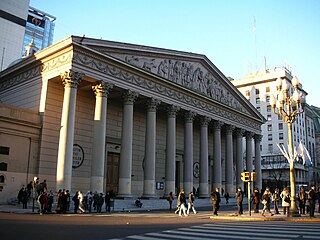
The Argentine Catholic Church, or Catholic Church in Argentina, is part of the worldwide Catholic Church, under the spiritual leadership of the pope, the Curia in Rome, and the Argentine Episcopal Conference.
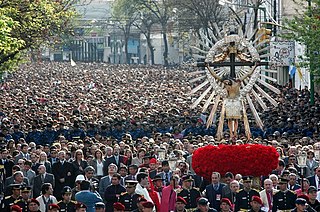
Christianity is the most widely professed religion in Argentina, with Roman Catholicism being its largest denomination. This historical background is very much due to the Spanish influence brought about through the newly conquered territories. However, affiliation with Protestant churches is increasing and immigration throughout the 20th century has brought other religions from various regions to Argentina.

The Diocese of Raleigh is a Latin Church ecclesiastical territory, or diocese, of the Catholic Church that covers eastern North Carolina in the United States. It is a suffragan diocese in the ecclesiastical province of the metropolitan Archbishop of Atlanta.

The Metropolitan Archdiocese of Agaña is a Latin Church ecclesiastical territory or diocese. It comprises the United States dependency of Guam. The prelate is an archbishop whose cathedral is the Dulce Nombre de Maria Cathedral-Basilica.
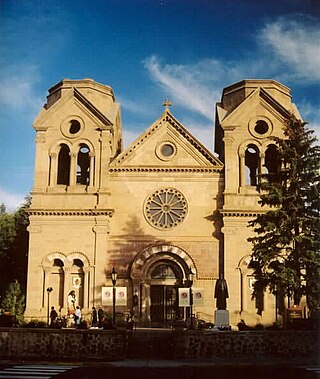
The Archdiocese of Santa Fe is a Latin Church ecclesiastical territory or diocese of the southwestern region of the United States in the state of New Mexico. While the mother church, the Cathedral Basilica of St. Francis of Assisi, is in the city of Santa Fe, its administrative center is in the city of Albuquerque. The Diocese comprises the counties of Rio Arriba, Taos, Colfax, Union, Mora, Harding, Los Alamos, Sandoval, Santa Fe, San Miguel, Quay, Bernalillo, Valencia, Socorro, Torrance, Guadalupe, De Baca, Roosevelt, and Curry. The current archbishop is John Charles Wester, who was installed on June 4, 2015.

The Archdiocese of Manila is the archdiocese of the Latin Church of the Catholic Church in Metro Manila, Philippines, encompassing the cities of Manila, Makati, San Juan, Mandaluyong, Pasay, Taguig, and Quezon City. Its cathedral is the Minor Basilica and Metropolitan Cathedral of the Immaculate Conception, also known as the Manila Cathedral, located in Intramuros, which comprises the old city of Manila. The Blessed Virgin Mary, under the title Immaculate Conception, is the principal patroness of the archdiocese.
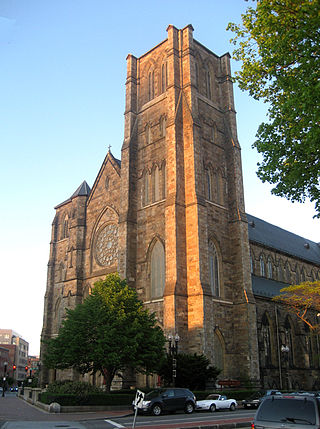
The Archdiocese of Boston is a Latin Church ecclesiastical territory, or archdiocese, of the Catholic Church in eastern Massachusetts in the United States. Its mother church is the Cathedral of the Holy Cross in Boston. The archdiocese is the fourth largest in the United States.

The Pontificia Universidad Javeriana is a private university in Colombia founded in 1623. It is one of the oldest and most traditional Colombian universities, directed by the Society of Jesus, with its main facilities in Bogotá and a second campus in Cali. "La Javeriana", as it is known by its students, has traditionally educated the Colombian upper class. It is one of the 33 universities entrusted to the Society of Jesus in Latin America and one of 167 around the world.

The Catholic Church in Chile is part of the worldwide Catholic Church, under the spiritual leadership of the Pope, the curia in Rome, and the Episcopal Conference of Chile.

The Metropolitan Archdiocese of Buenos Aires is a Latin Church ecclesiastical territory or archdiocese of the Catholic Church in Argentina. It is a metropolitan archdiocese with 13 suffragan sees in the country, including two Eastern Catholic eparchies.

The Diocese of Gibraltar is a Latin Church diocese of the Catholic Church in the British overseas territory of Gibraltar. About twenty priests and nine sisters serve in the diocese. Carmelo Zammit was installed as bishop on 24 September 2016. At just over 6 square kilometers, it is among the smallest of all Catholic dioceses in the world.
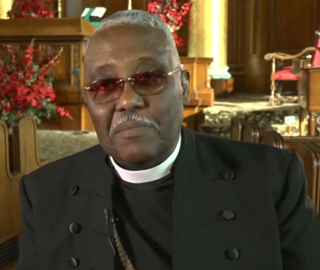
Jesse Delano Ellis, II, commonly known as J. Delano Ellis, was an American Protestant religious leader and progenitor of unity among African American Pentecostals with Trinitarian and nontrinitarian affinities.
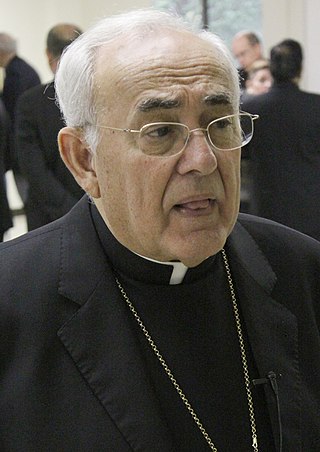
Álvaro Corrada del Río, S.J. is a Puerto Rican prelate of the Catholic Church and member of the Society of Jesus.

Luis Rafael Zarama Pasqualetto is a Colombian-born American prelate of the Roman Catholic Church who has been serving as the bishop of the Diocese of Raleigh in North Carolina since 2017. He previously served as an auxiliary bishop of the Archdiocese of Atlanta from 2009 to 2017
The Pontifical Commission for the Protection of Minors is a pontifical commission within the Roman Curia of the Catholic Church instituted by Pope Francis on 22 March 2014 as an advisory agency serving the pope. Since 5 June 2022, the Commission has been part of the Dicastery for the Doctrine of the Faith, operating with its officials and according to its norms.

Our Lady of Chiquinquirá Cathedral is a Roman Catholic cathedral situated in the city of Sonsón, Colombia. The present cathedral was built to replace the original destroyed by an earthquake in 1962.
Horacio del Carmen Valenzuela Abarca is a Chilean prelate of the Catholic Church, who was Bishop of Talca from 1996 to 2018.
Gonzalo Duarte García de Cortázar is a Chilean prelate of the Catholic Church who was Bishop of Valparaíso from 1998 to June 2018. Product of it, he also was the Great Chancellor of the Pontifical Catholic University of Valparaíso, his alma mater.
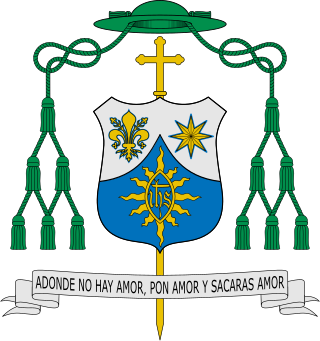
Alberto Arturo Figueroa Morales is a Puerto Rican prelate of the Catholic Church. He has been bishop of the Diocese of Arecibo in Puerto Rico since 2022. He served as an auxiliary bishop of the Archdiocese of San Juan in Puerto Rico from 2019 to 2022.